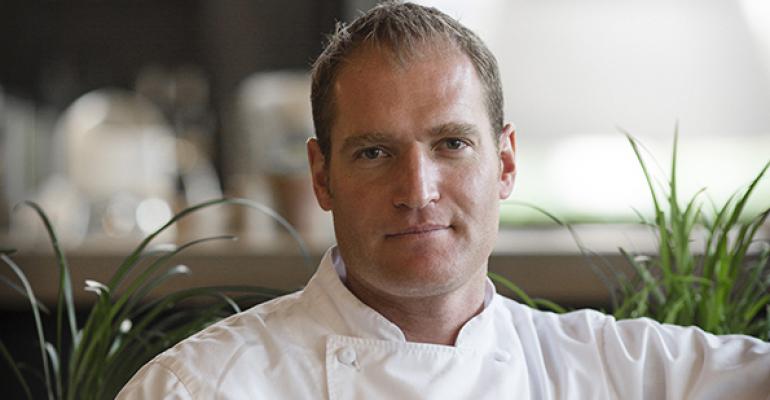Arik Markus became brand chef of Fox Restaurant Concepts’ True Food Kitchen brand in October. The New York City native got his start cooking in fine-dining restaurants in his hometown, including Daniel and Le Bernardin. He later became involved in healthful and sustainable concepts before taking his current job.
The menu of 10-unit True Food Kitchen is based on the nutritional principals of Andrew Weil’s anti-inflammatory diet. Markus discussed how he is adjusting the chain’s menu in response to new science, as well as to sustainability issues.
Dr. Weil’s anti-inflammatory diet isn’t necessarily related to sustainability issues. Have you changed True Food Kitchen’s purchasing stance as a result?
I think it’s all holistic. It’s really hard to separate one component from the whole equation, because if you want to put the best, most healthful, most wholesome product on the table for your guest, then you have to think about the supply chain and how [the food’s] getting to your back door in the first place.
Just to bring up an example of something that we’re changing this week, we’re no longer purchasing California almonds because of the drought impact. We’re switching to a Spanish almond, which we think is at least going to contribute more to the solution.
Spanish almonds are a lot more expensive than California almonds.
They are, so we eat into some of our profitability. But we’re able to take advantage of [Fox Restaurants’] larger purchasing volume and help manage costs. Everything is a push-pull, and I feel like if we can still run a successful business that still maintains higher and always-improving integrity standards, then we’re doing right by our guests, and we’re doing right by the business as well.
Are you looking at other sustainability-related menu changes?
There’s a massive offshore problem in California with diminishing food stocks for sea lions. We have a sardine dish that we run in two restaurants, and we’re going to make a change to that pretty much immediately, even if we’re going to upset some of our core constituents by not running this dish. There’s no great benefit to us in running a local product when the local stocks are diminishing and it’s impacting other populations besides people.
The reason the sardines are on the menu in the first place is because of how hyper-local they are. We don’t run it systemwide. We only run it in San Diego and Newport Beach. We don’t even run it in Santa Monica. And we’re going to be making a change to it. Mackerel is where I’m going, most likely.
What other local menu items do you have?
We have a sustainable fish feature that we have in the entrée section at dinner. The chefs at each location are using different species of fish that are more regionally specific and regionally appropriate in each of the 10 markets. Then I ask them to all go to their local farmers markets and shop for fresh produce that we include in the cruditées, so it’s always changing, always evolving and really hyper local.
But if you’re in a market with a short growing season, it’s going to be less so.
Sure. But there’s always a way, and we will always augment from more productive parts of the country if we need to. The supply chain’s there to make it happen. But I do charge the chefs with having those local relationships, because it’s important. It’s important for their growth, too. It’s not only for the benefit of True Food Kitchen, nor should it be. I want our chefs to continue to grow as chefs and as people and have ties to their local farmers and local producers.
Spring menu: The next kale
What are you excited about on your new spring menu?
We’ve upgraded our steelhead [trout] and changed to a new source. We’re using Loch Etive steelhead from Scotland. Great clean, cold, brackish waters. We’ve changed to this European purveyor because they use a certified non-GMO feed, and I really wanted to upgrade that.
There’s been a lot of conversation about what the next kale is going to be. I, for one, think cauliflower is a really great option. It’s incredibly versatile. It tastes great. You can eat it raw or cooked. So I’ve paired that steelhead with a raw cauliflower tabbouleh that’s dressed with tahini, preserved lemon vinaigrette, pine nuts, dates and a little watercress salad.
What does the cauliflower replace in traditional tabbouleh?
Bulgur. I’m keeping it grain free to go a more paleo-friendly route, having fewer carbs on the plate and going away from grains.
Do you have a lot of customers who don’t want to eat gluten?
We do. More and more, it seems, for varying reasons. For some it’s a real celiac allergy; for some it’s an intolerance; for many it’s a preference at this point.
I’m not a big believer in fake alternatives. If you really want a burger, then eat a burger. If you want a pizza, eat a pizza. And part of the issue I’ve had with food substitutes is that they’ve tasted and felt like substitutes. Don’t have your food pretend to be food it’s not.
But the blending of gluten-free flours has gotten so much better that they’re really difficult to tell, side by side, from a wheat flour cake.
There’s obviously a growing demand for these things, and we want to be out in front.
Contact Bret Thorn at [email protected].
Follow him on Twitter: @foodwriterdiary





